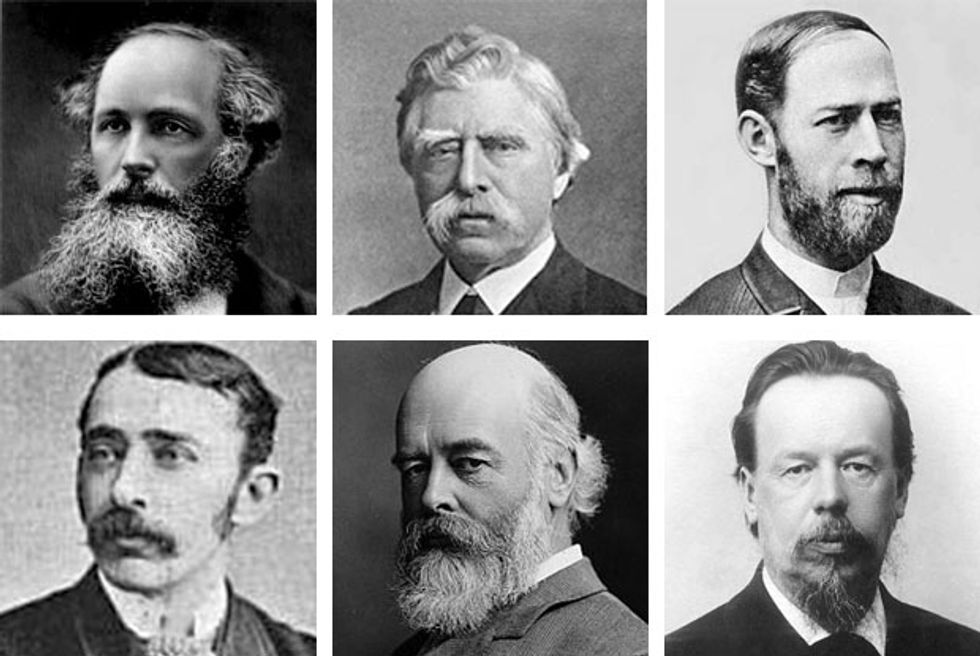Now that the world has become addicted to portable electronics, billions of people have come to see the companies providing these gadgets as the most innovative, and the people who head those companies as the most exalted, of all time. “Genius” is a starter category in this discussion.
But clever and appealing though today’s electronic gadgets may be, to the historian they are nothing but the inevitable fifth-order elaborations of two fundamental ideas: electromagnetic radiation, the theory of which was formulated by James Clerk Maxwell in the 1860s, and miniaturized fabrication, which followed Richard Feynman’s 1959 dictum [PDF] that “there’s plenty of room at the bottom.”
Maxwell was a true genius. The history of science offers few examples of work as brilliant as unifying electricity, magnetism, and light as aspects of a single phenomenon: electromagnetic waves. As Max Planck put it, “in doing so he achieved greatness unequalled.”
In late 1879 and early 1880, David Edward Hughes actually transmitted and received those invisible signals but did not publish his results. And in 1883, Thomas Edison also came very close to the actual use of such waves with his patent for an apparatus “showing conductivity of continuous currents through high vacuo.” He displayed it in 1884 at the International Electrical Exhibition in Philadelphia, then abandoned it as a mere curiosity.
That is why the second-order elaboration of electromagnetism came only between 1886 and 1888, when Heinrich Hertz deliberately generated and received electromagnetic waves whose frequencies he accurately placed “in a position intermediate between the acoustic oscillations of ponderable bodies and the light-oscillations of the ether.”

The third-order elaboration began with the first broadcasts, by Oliver J. Lodge and Alexander S. Popov, in 1894 and 1895, and it continued with the first transatlantic transmission, by Guglielmo Marconi in 1901; the first long-distance transmission of voice and music, by Reginald A. Fessenden in 1906; and the invention of vacuum tubes—John A. Fleming’s diode in 1904, Greenleaf W. Pickard’s point-contact diode (cat’s whisker) in 1906, and Lee de Forest’s triode in 1907.
By 1910, we thus had in place all the fundamental technical requirements for commercial radio, and even perhaps for primitive television. And in the 1920s we came close to solid-state electronics: Julius Edgar Lilienfeld filed to patent the concept of a field-effect transistor in 1925 in Canada and a year later in the United States. In 1934, Oskar Heil patented a similar device, and in 1939 Russell Ohl discovered the p-n junction. Consequently, even the Bell Labs Memorial site acknowledged that its scientists’ much-publicized invention of the transistor in 1947 was in fact a reinvention.
Solid-state devices opened the gates of the fourth-order elaboration, beginning with integrated circuits—a patent for which was filed in 1959—followed by microprocessors in 1971 and 1972. Bell Laboratories, RCA, Fairchild Semiconductor, Texas Instruments, and Intel were the leading enablers of this wave.
The fifth-order elaboration—the one that now receives all the adulation of the texting and tweeting masses—followed inexorably, as microprocessors proliferated in mobile communications. Once again, this elaboration was built on basic advances made long before.
As I pass the zombielike figures on the street, oblivious to anything but their cellphone screens, I wonder how many of them know that the most fundamental advances enabling their addictions came not from Nokia, Apple, Google, Samsung, or LG. These companies’ innovations are certainly admirable, but they amount only to adding a few fancy upper floors to a magnificent edifice whose foundations were laid by Maxwell 152 years ago and whose structure depends on decades-old advances that made it possible to build electronics devices ever smaller.
Not that that’s a small matter.
This article appears in the March 2017 print issue as “Thank Maxwell for Cellphones.”
Vaclav Smil writes Numbers Don’t Lie, IEEE Spectrum's column devoted to the quantitative analysis of the material world. Smil does interdisciplinary research focused primarily on energy, technical innovation, environmental and population change, food and nutrition, and on historical aspects of these developments. He has published 40 books and nearly 500 papers on these topics. He is a distinguished professor emeritus at the University of Manitoba and a Fellow of the Royal Society of Canada (Science Academy). In 2010 he was named by Foreign Policy as one of the top 100 global thinkers, in 2013 he was appointed as a Member of the Order of Canada, and in 2015 he received an OPEC Award for research on energy. He has also worked as a consultant for many U.S., EU and international institutions, has been an invited speaker in more than 400 conferences and workshops and has lectured at many universities in North America, Europe, and Asia (particularly in Japan).


